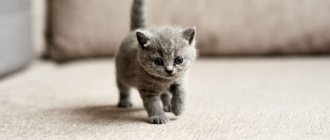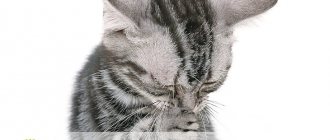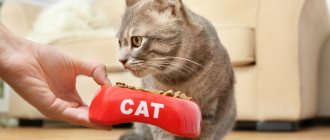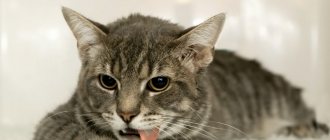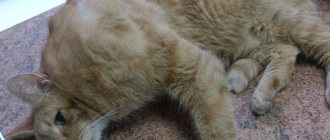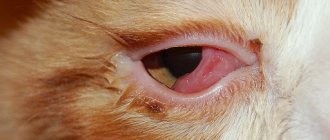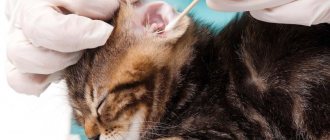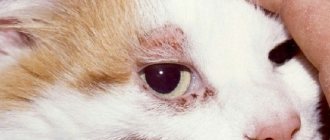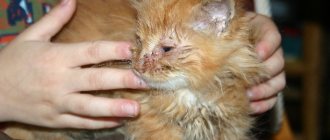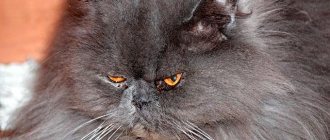The quantity, quality and frequency of urine excreted is the most important indicator of the health of a cat. It’s good when owners control their pet’s trips to the litter box. This will allow you to promptly detect that there is something wrong with the animal’s urinary system.
We will look at how many times a day a cat should pee, we will name the symptoms and possible causes of deviations from the norm, methods for identifying and eliminating pathologies, and we will also tell you how to prevent problems associated with impaired urination.
Features of the urinary system of cats and cats
There is nothing special in the structure of the kidneys, ureters and bladder of these animals, with one exception. The kidneys of cats are supported by very long ligaments, so they constantly change their position, like the wandering kidney in humans. This is a pathology only for humans, and mobile cat kidneys do an excellent job of producing and filtering urine.
Another thing is the urethra (urethra). In cats, this hollow tubular organ is quite short and wide. Its diameter allows you to painlessly remove sand and small stones, preventing blockage of the urinary tract.
The male urethra is long and thin, and along its length there are numerous narrowings (stenoses). In addition, it has an S-shape, which makes urination even more difficult.
Normally, the body of pets of both sexes excretes from 50 to 200 ml of urine per day, this depends on the size and weight of the animal. Now we’ll find out how many times a day a cat should pee.
When should you contact a veterinarian?
Having noticed that the cat has begun to rarely visit the litter box, it is necessary to observe whether other symptoms have appeared. If they are there, you can’t hesitate. Atypical behavior when urinating - a strange posture, meowing - should alert you.
Pathology is indicated by weakness, lethargy and apathy, excessive appetite or refusal to eat, and weight loss. Other reasons to contact a veterinarian:
- indigestion (vomiting, diarrhea or constipation);
- increased or decreased body temperature;
- pallor of the mucous membranes;
- uncharacteristic impurities in the urine (pus, blood);
- strong unpleasant odor of urine.
Some diseases have subtle symptoms, so if the deviation in the number of urination acts persists for more than 3 days, you should show your pet to a doctor. Under no circumstances should you self-medicate; this can aggravate the situation and lead to dangerous complications.
Why do cats pee more often?
When a cat goes to the toilet only twice a day, this is normal. If the animal is healthy and the cat is not overfed, the bladder is completely emptied and refills within 12 hours. If a cat is “walking” or carrying offspring, it may go to relieve itself more often, but this is a temporary phenomenon.
Sterilization has no effect on how many times a day a cat pees. At the end of the recovery period, urination is normalized to 1-3 times a day.
The long, tortuous urethra does not allow cats to completely empty themselves in one go. Neutered pets and stud cats visit the litter box at least 3-4 times a day. But the latter also mark their territory, which is not regarded as a full-fledged act of urination. Also, some owners note that after castration their cats begin to pee more often. This is also considered the norm.
However, there are exceptions to every rule, and there are cats that rarely relieve themselves throughout their lives and feel great. Therefore, when wondering how many times a day a cat should pee, it is important to take into account the individual characteristics of the animal and the conditions under which it is kept.
General information about the kitten's toilet
A kitten can go to the toilet anywhere from 10 times a day (in the early stages) to 5 times a day as it grows. If the kitten goes to the toilet too infrequently (up to 4 times a day), or goes to the toilet too often, or has other warning signs (blood, mucus in the urine), the owner should immediately contact a veterinarian.
On average, one-month-old kittens poop on their own 3 to 6 times a day. A kitten in a new place often does not go to the toilet for up to 5 days. If, after adaptation to the new place, the situation does not change, measures need to be taken.
The answer to the question of how often to change the tray depends on the composition of the toilet filler. In general, after each visit to the litter box by a kitten, there should be no traces or smell left in it, otherwise the kitten will try to find another secluded place to relieve itself.
What affects the process of urination in cats?
Animals, like people, are all very different. Some cats have been lazy and lazy since childhood, while others jump around in closets until old age. Among the cats there are little-eaters and gluttons, water-drinkers and those who drink very little. From here a number of patterns can be traced in the process of urination:
- Cats that eat little and sleep most of the day can go to the litter box once during the day and once at night.
- Lazy cats can endure for a long time in order not to make unnecessary movements, so they accumulate urine and pee rarely and a lot.
- How many times a day a cat should pee is known to the owners of active and active animals. Their pets will not tolerate it, they go to the toilet as needed, and if they often touch a bowl of water, they can go to the litter box up to 6 times a day.
And if a cat goes to the toilet in this mode all his life, then this is normal. As animals age, the number of acts of urination may gradually decrease or, conversely, become more frequent. This is due to the natural aging of the body and inhibition of urination function.
If in a short period of time a cat begins to pee less often or more often, or the amount of urine excreted has noticeably decreased or increased, this may be one of the symptoms of a disease, not necessarily of the urinary system.
What can cause urinary problems?
In some cases, the amount of urination may indicate an illness in your pet.
Don't worry if:
- The pet recently switched to a different diet
- Animal after castration.
- The cat suffered stress associated with global changes in her life. When she moved to another apartment, or another animal was placed with her.
All these factors lead to the fact that animals fall into apathy and have difficulty coping with changes in their usual way of life. This leads to health problems, in particular with urination. As a rule, the recovery process takes three days for cats, a couple of days longer for cats, but the animals manage without medical intervention. These animals are able to quickly rebuild and adapt to any changes in their lives. Give your furry friend a little time, and he will pee in the litter box the required number of times, despite the turmoil he has endured.
This is interesting: Ways to accustom an adult cat to the litter box
When to sound the alarm
Violation of the process of urination and its frequency after some time is accompanied by other signs of the development of pathological conditions. Therefore, it is important to pay attention to how many times a cat pees, the quality of its urine and the general condition of the animal. Owners should be alarmed by the following signs:
- cloudiness and change in the color of urine (instead of light yellow - orange, brown, the color of meat slop, or, conversely, colorless);
- a swollen or hard, tense abdomen, when stroking the cat reacts painfully or aggressively;
- the pet misses the tray and pees intensely;
- strong thirst appeared for no apparent reason;
- the appetite disappeared, the cat became lethargic or, conversely, restless.
The first sign of the development of many pathologies in cats is just a change in the quantity and quality of fluid secreted, which is why it is so important to monitor how many times a day a cat pees. Felines are one of the hardiest animals, and deterioration in their general condition often manifests itself only against the background of chronic processes.
Diet addiction
While it is possible to find a good balance between liquid and solid food with natural products, the problem arises when using dry food. In this case, a large consumption of water and, as a result, frequent trips to the tray are inevitable. Moreover, with a high frequency of urination, the owner should pay close attention to the quality and color of urine. In addition, note:
- the cat’s behavior in the toilet (calm, agitated, in pain when peeing);
- amount of urine based on average values;
- the presence of foreign impurities;
As practice shows, the diet of cats consisting exclusively of dry food is more often the cause of urolithiasis. To be fair, it is worth noting that the risk decreases when using premium feed and the proper amount of fluid consumed.
For castrated animals, experts recommend choosing a special diet. If your pet is mischievous, you can try feeding him through a syringe without a needle.
ATTENTION! If your pet's diet consists of dry food, then fluid intake should be increased by about 3 times
Causes of urinary dysfunction
A pet’s illness is a difficult ordeal for both it and its owners, but many problems with the animal’s health can be avoided. Let's consider the most common causes of the development of pathologies and their consequences:
- Overfeeding and obesity often lead to the development of diabetes. In this case, one of the clinical manifestations is frequent, copious painless urination, and sometimes urinary incontinence.
- An unbalanced diet, cheap food, fish in the diet, poor quality water, and a sedentary lifestyle provoke urolithiasis. Urination becomes frequent, painful, mixed with blood, or there may be a complete absence of urine while the urge persists.
- Hypothermia, stress, stagnation of urine, stones, and ureteral infections cause the development of cystitis. The first sign of bladder inflammation is very frequent, almost futile trips to the toilet.
- Vitamin B6 deficiency, helminthic infestations, and disturbances in the outflow of bile can cause cirrhosis of the liver. A striking clinical manifestation will be the orange color of urine excreted in large portions, often past the tray.
If you do not constantly monitor how many times a day your cat pees, it is easy to miss the manifestations of inflammatory kidney diseases, for example, pyelonephritis or glomerulonephritis. By the age of 8, the chronic form of the pathology turns into renal failure. The cat begins to drink a lot, go to the toilet up to 10 times a day, the urine becomes colorless and odorless.
Cats are not only very hardy, but also extremely patient, and a pet screaming in pain is actually an extremely rare occurrence. This often misleads owners and gives the false impression that everything is fine with the animal. Therefore, changes in the nature of urination should be an important reason for owners to show the cat to a specialist.
What are the reasons for deviations from the norm?
A distinction is made between pollakiuria—frequent urination and oliguria—decreased urine volume with infrequent visits to the litter box.
Pollakiuria develops for the following reasons:
- Aging : The sphincter of the bladder relaxes and urine flows to the outlet valve of the urethra. The pet squats all the time, trying to defecate,
- Cystitis : inflammation of the bladder accompanied by frequent and painful urination.
- Inflammation of the prostate: mainly affects older pets.
- Stress : fright, the appearance of a new pet in the apartment, the appearance of the owner after a long absence.
- Pathological conditions that cause thirst - poisoning, infectious or non-communicable diseases are accompanied by an increase in trips to the litter box.
Oliguria is associated with dehydration, which occurs with prolonged vomiting and diarrhea, or urolithiasis, when a complete cessation of urination is possible. This condition is called anuria, it threatens the life of the animal and requires emergency veterinary care.
Diagnostics
An experienced veterinarian can make a preliminary diagnosis simply by examining the pet and talking with the owners. He will definitely ask how often the cat pees. However, in most cases, one or more diagnostic measures are required:
- urinalysis is an important study that allows you to detect changes in the pH and density of urine, sand, salts, protein, glucose;
- biochemical blood test is a highly informative diagnostic method that determines the condition of internal organs and systems;
- Ultrasound of the abdominal organs is now practiced in most veterinary clinics for the timely detection of infectious, inflammatory and tumor diseases.
Based on the diagnostic results, the doctor prescribes treatment. It is necessary to fight for the animal, especially since modern veterinary medicine has all the necessary means for treatment.
How is a ureteral stent removed?
Removal of a ureteral stent occurs on an outpatient basis and takes much less time than the procedure for its installation. Currently, there are several ways to remove a stent. The first traditional one is cystoscopic. The second is using threads that are tied to a stent and exit through the external opening of the urethra. The third method is applicable only to women and involves using a special sterile loop under X-ray or ultrasound control. The fourth method is less common due to the high cost of the special stent with a magnet used.
In cases of stent encrustation, entanglement, or migration, surgical treatment may be required.
Treatment
It is clear that in each case, therapy is prescribed individually, but we can consider the general principles of treating cats for the most common diseases:
- For urolithiasis, antibiotics and antispasmodics are prescribed, and a urinary catheter may be installed. When the urinary tract is blocked by stones, surgery is performed.
- To treat cystitis in cats, antibiotics and diuretics are used in the form of injections and droppers.
- In case of liver damage, the water balance in the body is first restored, then hepatoprotectors are prescribed.
- With diabetes, some cats remain insulin dependent for life, while the health of others is maintained by glucose-lowering medications.
Following the doctor's recommendations, many owners literally pull animals out of the dead. The veterinarian will tell you how many times a day a cat who has suffered a serious illness should pee, and will certainly prescribe a diet. And this is an important preventive measure to prevent the development of dangerous pathologies in cats.
Prevention
The incidence of urolithiasis in cats is five times higher than in cats. This disease is one of the most frequently diagnosed after helminthic infestations.
Proper metabolism prevents the formation of stones, so a balanced diet is the key to health, especially when it comes to castrated and sterilized cats. These are truisms, but owners, even when buying premium food, do not comply with the feeding standards indicated on each package, so they mix the finished product with natural food.
Lack of water is one of the reasons for the formation of urate stones, and since cats have a poorly developed sense of thirst, there is a good way to teach your pet to drink more. Place several different vessels with water in different places in the house, this invariably arouses interest in the animals and a desire to try.
Protect your cat from hypothermia. Don't let him sit on a freshly washed floor until it's dry, and don't let him sleep on the floor under an open window. And, of course, watch how often the cat pees. This is the most important marker in home diagnostics of a pet’s health condition.
Accustoming a kitten to adult food and litter tray
Starting from the 22nd week of a kitten’s life, it can be gradually introduced to complementary foods. To do this, you can use special canned food for kittens. If food is prepared independently, then the baby should be given it chopped. Gradually, the amount of mother's milk in the kitten's diet decreases, and it completely switches to adult food. At this time, his feces change their structure and shape. They become more formed and dense. At the same time, it is advisable to start accustoming your baby to the tray. The toilet should be placed next to the box where he lives and sleeps. The sides of the tray should be low so that the baby can climb into it himself. It is better to choose crumbly filler. This will help the kitten develop a digging reflex and get used to the toilet.
The frequency of replacing the litter in the tray depends on how often the kittens poop and pee.
The ideal option would be to help a mother cat. Kittens willingly follow the example of adults. If a cat goes to the litter box when the baby is present, the kitten will quickly learn to do this on its own. Over time, the tray can be moved to another more suitable location.
